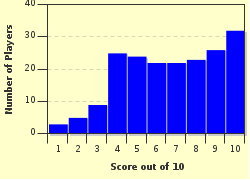Quiz Answer Key and Fun Facts
1. As the rain pelts down, the opening piece from our concert is the very appropriate "Cloudburst". Who composed it?
2. As thunder shakes the building, the orchestra moves on to a Beethoven piece that reflects what is going on outside. Which one?
3. With the lights flickering and the storm worsening, the orchestra's next choice is "Thunder and Lightning Polka". Which Strauss composed this?
4. With the thunder and lightning abating, the wind starts rising and the orchestra responds with "The Ride of the Valkyries". Which opera does this come from?
5. With the wind still screaming and the rain starting to fall, the orchestra decides they like the Wagner theme and move on to an overture and that depicts increasing waves and an approaching storm at sea. Which opera is this from?
6. With the concert hall being battered by the storm, the orchestra competes with the weather and stays with the operatic theme. The orchestra chooses the second movement of a Rossini overture. Which one?
7. At last the weather is improving, but as the skies clear the temperature drops. Responding to this, the orchestra moves to which Vivaldi piece?
8. The sky is now clear of storm clouds and it is a beautiful night. The orchestra, relieved to be able play something more peaceful, gives us which beautiful piece by Dvorak?
9. The concert is coming to a close and for their penultimate piece the orchestra picks a Berlioz piece from "Les Troyens". Which one would fit the theme of our evening?
10. The orchestra wants to send us home happy, so for their final piece they move to about the only type of weather we haven't had this evening - snow. They close with the ever popular light orchestral piece, "Sleigh Ride". Who wrote this?
Source: Author
StarStruck60
This quiz was reviewed by FunTrivia editor
Pagiedamon before going online.
Any errors found in FunTrivia content are routinely corrected through our feedback system.

